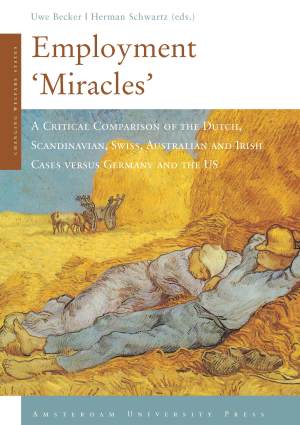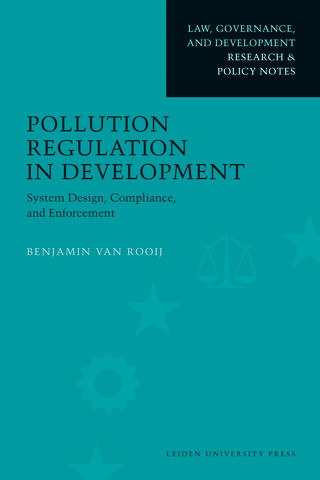
Vanaf 1 oktober worden Engelstalige AUP-boeken uitgegeven door Taylor & Francis. Meer informatie: AUP en Taylor & Francis werken samen aan Engelstalig boekenprogramma
Uwe Becker, Herman Schwartz (red.)
Employment 'Miracles'
A Critical Comparison of the Dutch, Scandinavian, Swiss, Australian and Irish Cases versus Germany and the US
Was de 'miraculeuze' ontwikkeling van de werkgelegenheid in de jaren ’90 en net na de eeuwwisseling in onder andere Australië, Nederland en Denemarken inderdaad een wonder, of lag hieraan een uitgekiende strategie ten grondslag? Meestal wordt de oorzaak gezocht in het economisch beleid en de loonmatiging zoals vastgelegd in cao’s, die een toenemende export en een afnemende werkloosheid tot gevolg zouden hebben gehad.
Dit vijfde deel in de serie Changing Welfare States laat zien dat toevallige omstandigheden minstens zo belangrijk zijn voor de banengroei als een weloverwogen beleid. Opvallend is vooral de invloed van een sterke huizenmarkt op de economische groei en werkgelegenheid. Loonmatiging, vaak beschouwd als doorslaggevende factor, maakt daarentegen weinig verschil. Hetzelfde geldt voor neoliberale stokpaardjes als het snijden in de uitkeringen en flexibilisering van de arbeidsmarkt om een sterke concurrentiepositie te behouden.
Becker en Schwartz laten zien dat de meeste van de onderzochte landen, vooral Scandinavische, door de handhaving van een genereus sociaal bestel een reëel alternatief bieden voor de dominante liberale weg naar werkgelegenheidsgroei.
Dit vijfde deel in de serie Changing Welfare States laat zien dat toevallige omstandigheden minstens zo belangrijk zijn voor de banengroei als een weloverwogen beleid. Opvallend is vooral de invloed van een sterke huizenmarkt op de economische groei en werkgelegenheid. Loonmatiging, vaak beschouwd als doorslaggevende factor, maakt daarentegen weinig verschil. Hetzelfde geldt voor neoliberale stokpaardjes als het snijden in de uitkeringen en flexibilisering van de arbeidsmarkt om een sterke concurrentiepositie te behouden.
Becker en Schwartz laten zien dat de meeste van de onderzochte landen, vooral Scandinavische, door de handhaving van een genereus sociaal bestel een reëel alternatief bieden voor de dominante liberale weg naar werkgelegenheidsgroei.
Redacteuren
- Titel
- Employment 'Miracles'
- Subtitel
- A Critical Comparison of the Dutch, Scandinavian, Swiss, Australian and Irish Cases versus Germany and the US
- Redacteuren
- Uwe Becker
- Herman Schwartz
- Prijs
- € 56,95 excl. BTW
- ISBN
- 9789053567555
- Uitvoering
- Paperback
- Aantal pagina's
- 288
- Taal
- Engels
- Publicatiedatum
- 04 - 04 - 2005
- Afmetingen
- 17 x 24 cm
- Open access
- Download op Open Access Platform
- Serie
- Changing Welfare States
- Categorie
- Politics and Government
- Discipline
- Social and Political Sciences
Table of Contents - 6
Preface - 10
1 Introduction:Miracles,Mirages and Markets - 12
Introduction - 12
Luck, pluck and stuck in the employment miracles - 17
Globalisation and the miracles - 20
A specific (corporatist) variety of capitalism? - 26
What the chapters say - 35
2 The Dutch Model:Magic in a Flat Landscape? - 40
Introduction - 40
Labour market performance - 43
Economic performance - 46
Social outcomes - 49
Policies, the model and the results - 53
Conclusion: luck, pluck or stuck? - 59
3 Employment and Unemployment in Denmark and Sweden:Success or Failure for the Universal Welfare Model? - 66
Introduction - 66
Employment and unemployment: what happened? - 67
Unemployment and employment policies - 73
Policies and outcome – Is there a link? - 78
Conclusions - 81
4 The Evolution of the Finnish Model in the 1990s : From Depression to High-Tech Boom - 88
Introduction - 88
The background of the Finnish miracle: the economic crisis of the 1990s - 90
Political response to the crisis - 94
The recovery and the Finnish ‘miracle’ - 95
Structural issues:welfare state and labour market institutions - 104
The Nordic welfare state: Good to economic growth? - 105
Labour market institutions and corporatism - 106
Conclusion - 108
5 The Swiss Miracle:Low growth and high employment - 112
Introduction - 112
Corporatism in a fragmented polity - 112
A coordinated market economy? - 115
Recent developments - 116
Economic and labour market development - 118
Disentangling the Swiss ‘miracle’ - 122
An expanding welfare system - 128
Conclusion - 131
6 Recasting the Story of Ireland’s Miracle:Policy,Politics or Profit? - 134
The constituents of economic growth and development - 135
Possible explanations - 138
The costs: sustainability? - 146
The significance of the Irish case - 153
7 The Australian Miracle:Luck,Pluck or Being Stuck Down Under? - 158
Introduction - 158
Exports and the current account balance - 166
Employment and collective bargaining - 172
Fiscal balance - 179
Conclusion - 182
8 Last Year’s Model? Reflections on the American Model of Employment Growth - 184
Introduction - 184
An American success story 185 - 186
The American model - 190
Limits to the liberal market economy model - 196
Conclusion - 203
9 The German Contrast.On Bad Comparisons,Special Circumstances,Luck and Policies That Turned Out to Be Wrong - 206
‘Germany isn’t working’ - 206
The German economy in comparison - 209
A bad employment record because of labour market and welfare rigidities? - 212
Accidental circumstances: housing bubble versus unification - 218
On strong German regions - 224
Prospects and possible lessons from the ‘model cases’ - 228
10 Conclusion:The Importance of Lucky Circumstances,and Still the Liberal-Social Democratic Divide - 232
In sum - 232
Recent developments and prospects - 234
What is to be learned? - 240
‘Competitive Corporatism’? - 242
Still the liberal-social democratic divide - 245
Contributors - 280
Index - 284
Bibliography - 250
Recensies en Artikelen
Employment “miracles” challenges the conventional wisdom that full employment and good overall economic performance is a function of a particular recipe of policies and institutions. To the extent that deliberate policies have played a role in recent success stories, they are embedded in nationally specific social, economic, and political institutions, which cannot be easily emulated.
The book therefore offers a stern warning against the temptation, so rarely resisted, to draw sweeping generalizations from particular national “models.” But while there is no magic bullet, the book is optimistic about the capacity of countries with very different institutions to be successful in a fiercely competitive global economy.
There is no necessary tradeoff between competitiveness and a large redistributive welfare state, and success is not synonymous with US-style deregulation. This is a point that is brought out in a nuanced and insightful fashion by the individual country chapters. Anyone interested in understanding the relationship between the economy, public policy, and economic performance is well-advised to read this important and timely new book.
Torben Iversen
Professor of Government
Center for European Studies
Harvard University




